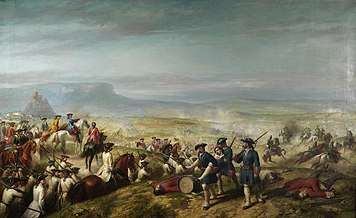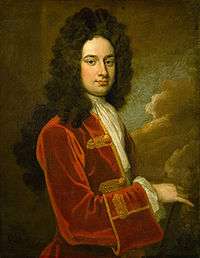George Carpenter, 1st Baron Carpenter
Lieutenant-General George Carpenter, 1st Baron Carpenter of Killaghy (10 February 1657 – 10 February 1731) was a British army officer and politician who sat in the House of Commons from 1715 to 1727. He was Commander-in-Chief in Scotland between 1716 and 1725.
George Carpenter, 1st Baron Carpenter of Killaghy | |
|---|---|
 Lord Carpenter by John Faber Jr, after Johan van Diest, about 1719 or soon after. | |
| Born | 10 February 1657 Ocle Pychard, Herefordshire, England |
| Died | 10 February 1732 (aged 74–75) Longwood House, Hampshire England |
| Buried | |
| Allegiance | |
| Service/ | Cavalry |
| Years of service | 1672–1725 |
| Rank | Lieutenant General |
| Unit | Colonel 3rd the Kings Own 1703-1732 |
| Commands held | Commander-in-Chief North Britain (sic) 1716-1725 Governor of Menorca (sic) |
| Battles/wars | Nine Years' War The Boyne Aughrim War of the Spanish Succession Almansa Almenara Brihuega Jacobite rising of 1715 Preston |
| Awards | MP for Newtownards[lower-alpha 1] 1703-1705 Whitchurch 1715-1722 Westminster 1722-27 |
Life
Carpenter was born 10 February 1657 in Ocle Pychard, Herefordshire, youngest of seven children. His parents were Warncombe and Eleanor Carpenter, whose family had owned property in the county for over 400 years, the main estate being Homme near Dilwyn.[1] Herefordshire was part of the Royalist heartland during the Wars of the Three Kingdoms and Warncombe served in the army of Charles I.
In 1671, Carpenter was appointed as Page[lower-alpha 2] to Ralph Montagu, Charles II's Envoy to Louis XIV of France. He returned home the next year and began a military career that lasted until 1725.
Career
Carpenter's appointment to Montagu's household shows his family were well-connected; the Montagus supported Parliament in the Civil Wars but were key players in the 1660 Restoration. Ralph's brother Edward, the Earl of Sandwich[lower-alpha 3] was a close associate of the future James II before his death at the Battle of Solebay in 1672. Ralph Montagu's role as Envoy was extremely sensitive as the 1670 Secret Treaty of Dover committed Charles to support France in the deeply unpopular Anglo-Dutch War of 1672-74.[lower-alpha 4] Despite this, Montagu opposed James during the Exclusion Crisis, supported William III in the 1688 Glorious Revolution and later became a Whig. These connections were an important element in Carpenter's career.

In 1685, Carpenter joined the 'Earl of Peterborough's Regiment of Horse', a new regiment raised when James II expanded his army after the Monmouth rebellion.[lower-alpha 5][2] The Earl of Peterborough[lower-alpha 6] was a Catholic who remained loyal to James in 1688 and was replaced as Colonel by Edward Villiers. During the Nine Years War, Carpenter served in Ireland as Lt-Colonel of what was now 'Villiers Regiment,' fighting at the Boyne and Aughrim. When the Treaty of Limerick ended the war in Ireland in October 1691, the regiment returned to England.[3]
In 1693 Carpenter married Alice Margetson, daughter of the Irish peer William Caulfeild, Viscount Charlemont and a widow whose previous husband John Margetson died at the first Siege of Limerick in 1690. In January 1694, Brigadier-General Richard Leveson became Colonel and as 'Leveson's Regiment of Horse' the unit was based in Flanders until the Treaty of Ryswick in 1697; Carpenter's son George was born in 1697 in Ghent. In 1703 he purchased the position of Colonel of the 3rd the Kings Own regiment, a position he held until 1732. He also acquired that year the estates of Baramount and Killaghy in County Kilkenny and became Member of Parliament for Newtownards in the Irish Parliament.[4]

During the War of the Spanish Succession, Carpenter was appointed Quartermaster and General of Cavalry in the Anglo-Dutch force led by Charles, 3rd Earl of Peterborough sent to Spain in 1704 to support Archduke Charles, Austrian candidate for King of Spain. In 1706 James Stanhope was appointed English Minister in Spain; at Almansa in 1707, Carpenter's repeated cavalry charges mitigated an Allied defeat by saving the guns and baggage train. Stanhope replaced Peterborough as military commander in 1708; Carpenter took part in the victory at Almenara in 1710 but a few months later was badly wounded and taken prisoner with many others including Stanhope at Brihuega. This ended the war in Spain in favour of Phillip V; Carpenter was later exchanged and promoted to Lieutenant-General.[5]
Stanhope was a prominent Whig [lower-alpha 7] and when George I succeeded Queen Anne in 1714, Carpenter was nominated Envoy to Emperor Charles VI. Before taking this position the Jacobite rising of 1715 broke out and Carpenter was put in charge of government forces in Northern England. He prevented the Jacobites seizing Newcastle, forcing them into the Battle of Preston where they were attacked by troops under Major-General Charles Wills. The first assaults were repulsed but the Jacobites were surrounded by Wills and Carpenter and surrendered on terms.[6] Wills and Carpenter served together in Spain and had quarrelled at some point; Carpenter later claimed Wills was taking all the credit for Preston and challenged him to a duel which was prevented by mutual friends.[5][4]
Carpenter was returned as Member of Parliament (MP) for Whitchurch in Hampshire at the 1715 general election. He served as Governor of Menorca from 1716 to 1718 and Commander-in-Chief, North Britain (sic) from 1716 to 1724. He was created Baron Carpenter, of Killaghy in the County of Kilkenny in the Peerage of Ireland on 29 May 1719.[7] In December 1722 he was elected MP for Westminster after the Westminster results of the 1722 general election were declared void. He did not stand at the 1727 general election.[8]
Carpenter died on 10 February 1732 a few months after his wife and was buried in the church of Owslebury in Hampshire.
Family
George and Alice (ca 1660 - 7 October 1731) had two children;
- George Carpenter, later 2nd Baron Carpenter (20 April 1697 - 12 July 1749); like his father, he had a long career as both soldier and MP;
- Alicia Carpenter (1705? – died before 1714);
Alice also had two daughters from a previous marriage;
- Anne Margetson (ca 1680 - 1693);
- Sarah Ponsonby (ca 1681 - May 1733); married (1) Hugh Colville, (2) Earl of Bessborough
Coat of arms
Lord Carpenter's Arms appear to be of French or Norman heritage, "Paly of six, argent and gules, on a chevron azure, 3 cross crosslets or." Crest, on a wreath a globe in a frame all or. Supporters, two horses, party-perfess, embattled argent and gules. Motto: "Per Acuta Belli" (Through the Asperities of War). These arms descend from John Carpenter, the younger (c. 1372 – 1442) who was the noted Town Clerk of London during the reigns of King Henry V & King Henry VI.[9]
These arms are often referred to as the Hereford Arms, named for the later ancestral home of the Carpenter family in Hereford, England. The crest, supporters & motto apparently has changed several times over the centuries.[10]
Sir William Boyd Carpenter (1841–1918), an English clergyman of the Established church of England, Bishop of Ripon, afterwards a Canon of Westminster and Chaplain to the reigning sovereign of England, wrote in a letter dated 7 August 1907 that his family bore the Hereford Arms. Sir Noel Paton, upon painting the Family Arms, informed him that the supporters were originally a round-handled sword, which in drawing over time became shortened, until nothing but the cross and globe were left beneath it. Those Hereford Arms were used by "John Carpenter, town clerk of London, who died 1442 A. D."[10] His grandson John Boyd-Carpenter, Baron Boyd-Carpenter (1908–1998), continued the Arms into the new century by passing it down to his son, Thomas Boyd-Carpenter, who was himself knighted after a military career as a Lieutenant-General and for public service.[10]
There is no direct male to male Carpenter descent connecting Lord Carpenter & Sir William Boyd Carpenter. The family connection is by marriage through the females in the family.[11]
The Hereford Coat of Arms described above should not be confused with the Arms of Bishop Richard Carpenter (c1450s?–1503) presented in the "Visitations of the County of Oxford taken in 1566, 1574, and 1634, published in 1871, which describe the arms displayed in the buildings at the University in Oxford – "In the Lyberarye of Baliall College." – as recorded by the officials performing the visitations in those years. The Visitations describe the arms of Bishop Richard Carpenter (c1450s–1503) as: "Paly of nine Gu. and Az. on a chevron Arg. surmounted by a mitre Or, three cross crosslets of—nine pales alternating red and blue, with a silver chevron bearing three gold cross-crosslets.[12]
Notes
- In the Irish Parliament, then a separate body from that in Westminster
- A position customarily held at the time for young gentleman beginning a political career.
- The diarist and naval administrator Samuel Pepys was his cousin.
- In return, Louis paid Charles a yearly pension of £230,000 with the promise of a large cash sum when he publicly announced his conversion to Catholicism; these terms remained hidden until nearly a century later.
- At this time, regiments were typically named after the Colonel and changed names when a new Colonel was appointed.
- Not to be confused with his Williamite nephew Charles who succeeded him in June 1697.
- There is some debate as to whether he should be considered the first modern Prime Minister, rather than Robert Walpole.
References
- Watkins, C, Cowell, Ben (2015). Uvedale Price (1747-1829): Decoding the Picturesque. Boydell Press. p. 36. ISBN 1783270233.
- "1685 to 1899 - A Short History of 1st The Queen's Dragoon Guards". Regimental Museum of the 1st The Queen’s Dragoon Guards (The Welsh Horse). Archived from the original on 23 July 2018. Retrieved 26 July 2016.
- Richards, p. 27
- A Genealogical History of the Dormant, Abeyant, Forfeited and Extinct Peerages of the British Empire. Burke, Bernard, Sir. 1866.
- Chalmers, Alexander (1812). "George Lord Carpenter (1657–?) (vol. 8, p. 271)". The General Biographical Dictionary, 1812–1817. online & OCR version by Liam Quin. Retrieved 16 January 2010. OCR version 2011
- Lenman, Bruce (1980). The Jacobite Risings in Britain, 1689-1746. Methuen. pp. 124–125. ISBN 0413396509.
- "No. 5742". The London Gazette. 2 May 1719. p. 1.
- "CARPENTER, George (1657-1732), of Longwood House, Hants". History of Parliament Online. Retrieved 17 September 2018.
- Historical Manuscripts Commission, UK National Register of Archives, George Carpenter (1657–1732) 1st Baron Carpenter Lieutenant General, HMC.gov.uk
- Utah Genealogical and Historical Magazine; vol. 16, Number 2, April 1925, Page 60–70, article by J. Hatton Carpenter "The Carpenter Family of England and the United States."
- "Carpenters Encyclopedia of Carpenters" published as a two data DVD set in 2009 by John R. Carpenter of the Cousins Project.
- Visitations of the County of Oxford taken in 1566, 1574, and 1634, published in 1871.
| Parliament of Great Britain | ||
|---|---|---|
| Preceded by Frederick Tylney Thomas Vernon |
Member of Parliament for Whitchurch 1715–1722 With: Thomas Vernon 1715–1721 Frederick Tylney 1721 John Conduitt 1721–1722 |
Succeeded by John Conduitt Thomas Vernon |
| Preceded by Archibald Hutcheson John Cotton |
Member of Parliament for Westminster 1722–1727 With: Charles Montagu |
Succeeded by Lord Charles Cavendish William Clayton |
| Peerage of Ireland | ||
| New creation | Baron Carpenter 1719–1731 |
Succeeded by George Carpenter |
| Military offices | ||
| Preceded by John Campbell, 2nd Duke of Argyll |
Commander-in-Chief, Scotland 1716–1724 |
Succeeded by George Wade |
| Preceded by John Campbell, 2nd Duke of Argyll |
Governor of Menorca 1714–1732 |
Succeeded by Richard Kane |